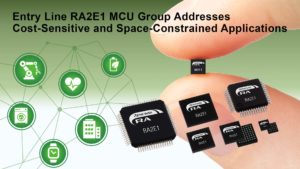Renesas Electronics Corporation, a supplier of advanced semiconductor solutions, announced the expansion of its 32-bit RA2 Series microcontrollers (MCUs) with 48 new RA2E1 Group MCUs. Based on the 48-MHz Arm Cortex-M23 core, the RA2E1 MCUs are entry-line, single-chip devices with up to 128-KB code flash and 16-KB SRAM memory.
 The RA2E1 Group MCUs support a wide operating voltage range of 1.6V to 5.5V and a large selection of packages such as LQFP, QFN, LGA, BGA, and Wafer Level Chip Scale Package (WLCSP). They deliver optimized combinations of superior performance, ultra-low-power consumption, innovative peripherals, and small package options.
The RA2E1 Group MCUs support a wide operating voltage range of 1.6V to 5.5V and a large selection of packages such as LQFP, QFN, LGA, BGA, and Wafer Level Chip Scale Package (WLCSP). They deliver optimized combinations of superior performance, ultra-low-power consumption, innovative peripherals, and small package options.
These features make the RA2E1 Group ideal for cost-sensitive applications and other systems requiring high performance and low-energy consumption in space-constrained applications. The new MCUs offer an upgrade path with hardware and software scalability, so they are the perfect entry point into the wide line-up of the Renesas RA family.
“The RA2E1 Group is an important addition to our RA Family,” said Roger Wendelken, Senior VP of Renesas’ IoT and Infrastructure Business Unit. “These devices are outstanding for any designer, delivering a wide range of popular features and options for applications, such as consumer products, appliances, and industrial equipment. Additionally, they serve as an entry point into our RA2 Series, offering a seamless upgrade to larger RA Family devices with hardware and software scalability.”
The upgraded low power capability in the RA2E1 MCUs covers all on-chip peripherals, flash memory, and SRAM. This capability allows the smallest possible power consumption over the devices’ entire temperature and voltage range. System design flexibility is maximized across diverse applications via multiple low power modes.
When benchmarked for power consumption, the RA2E1 MCU was certified with an EEMBC ULPMark score of 321 at 1.8V, verifying its best-in-class power rating. Users can now minimize active power consumption close to standby levels to extend battery life.
Features:
- 48 MHz Arm Cortex-M23 CPU core
- Integrated flash memory options from 32 to 128KB; and 16KB RAM
- Support for wide operating voltage range: 1.6 – 5.5V
- Pin counts from 25 to 64-pin
- Package options including LQFP, QFN, LGA, BGA, and WLCSP (2.14 x 2.27mm)
- Low power operation: 100µA/MHz in active mode; 250 nA in software standby
- Integrated next-generation innovative capacitive touch sensing unit with no external components required, lowering BOM costs
- Enables system costs reduction with on-chip peripheral functions, including a high precision (1.0 percent) internal oscillator, background operation data flash supporting 1 million erase/program cycles, high-current IO ports, and a temperature sensor
- Pin and peripheral compatibility with RA2L1 Group devices for quick and easy upgrade paths
The RA2E1 MCUs also offer an IEC60730 self-test library and feature integrated safety functions that confirm normal operation. Customers can easily use these safety functions to perform MCU self-diagnostics. Also, the RA2E1 devices include an AES cryptography accelerator, a true random number generator (TRNG), and memory protection units that provide the fundamental blocks to develop a secure IoT system.
The RA2E1 Group is supported by the easy-to-use Flexible Software Package (FSP), which includes a best-in-class HAL driver. The FSP uses a GUI to simplify and dramatically accelerate the development process, while also making it easy for customers to transition from an original 8/16-bit MCU design. Designers using the RA2E1 MCUs also have access to the extensive Arm partner ecosystem, offering a wide range of tools that help speed time-to-market.
The RA2E1 MCUs can be combined with Renesas’ complementary analog and power offerings to create comprehensive solutions for a variety of applications. Renesas has released a series of these “Winning Combinations” that include Arm core processors and are suitable for the low-cost, low pin-count, and low-power of the RA2E1 MCUs.
The RA2E1 kits also support new extended PMOD connectors to facilitate modular IoT using sensor PMODs and RF connectivity PMODs.
Filed Under: Components, News


Questions related to this article?
👉Ask and discuss on EDAboard.com and Electro-Tech-Online.com forums.
Tell Us What You Think!!
You must be logged in to post a comment.